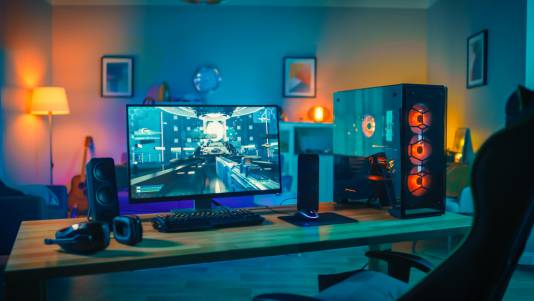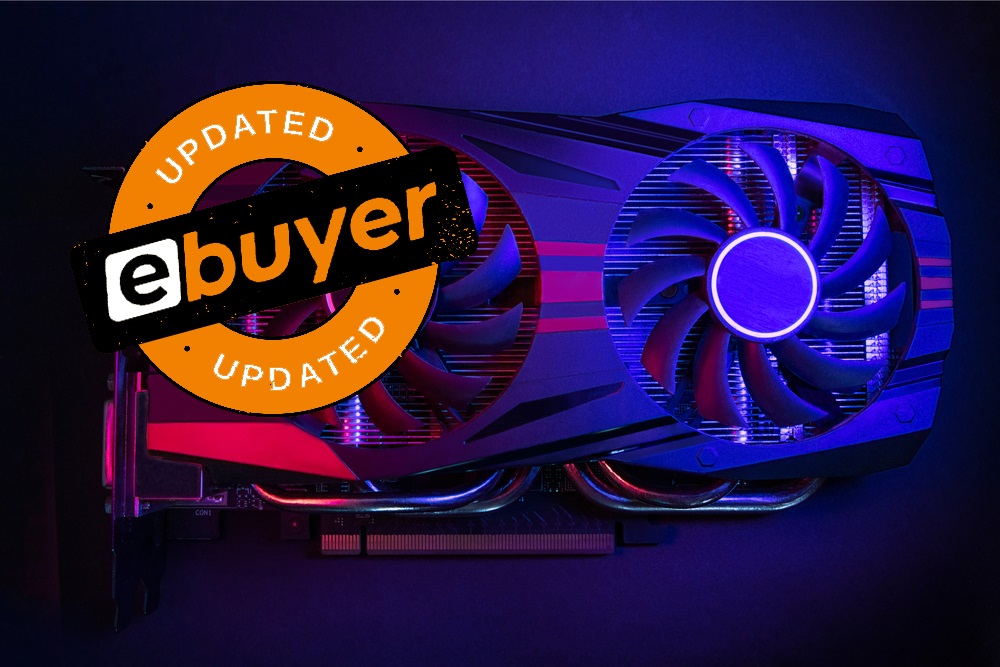This blog was updated in June 2022.
Whether you favour a dedicated gaming PC or a gaming laptop, you probably know that a lot of complex and nifty components go into making these computers capable of running triple-A games.
One of these key components is the graphics card, arguably the key component when it comes to gaming. But while the functions of your hard drive and processor might seem obvious, how do graphics cards work?
To help you wrap your head around this most vital of components, we’ve pooled our knowledge to create this guide on graphics cards, GPUs, and what they do.
What is a graphics card used for?
When it comes to answering the question of what do graphics cards do, the graphics card definition is quite simple. A graphics card is the piece of computer hardware that’s responsible for producing the images you see on your display. Without it, you wouldn’t be able to game.
It does this job by converting data into a signal your display can understand. The better your graphics card, the better and faster an image can be produced. Naturally, this is very important for gamers and content creators to ensure maximum graphical fidelity
What does a graphics card look like?
Your graphics card looks like a smaller, usually chunkier, version of your motherboard. If you were to take the side off your PC or the back off your laptop, you’d be able to spot your graphics card as the circuit board with fans attached to your motherboard.
Graphics cards are built this was due to their tech needs and the equip them with the fans needed to keep it running cool and efficient.
Different types of graphics cards
When it comes to the types of graphics cards available, you have the option between integrated or discrete models.
Integrated graphics cards are built directly into the processor with no add-in card necessary. You’ll find integrated graphics in most non-gaming devices, like thin-and-light laptops and home desktop PCs.
Integrated graphics are cost-effective but not very powerful, and because they’re ‘fixed’, they cannot be upgraded. They’re ideal for a lighter workload such as video playback or2D gaming.
Discrete graphics cards, on the other hand, are an add-in graphics card that’s installed into a motherboard’s PCIe slot as an extra component. This is ideal for those wanting to modify their PC’s performance by upgrading their graphics card at a later date.
Most people using a modern PC for standard day-to-day tasks, like browsing the internet, creating documents, and watching movies, will be well served with integrated graphics cards
For people branching out into high-FPS gaming or video editing, however, a discrete graphics card is needed to speed up the processing time. Without a discrete graphics card, the user may find their game dropping frames or stuttering at crucial moments.
What is a GPU in a computer?

Before we get too in-depth into the specifics of graphics cards, let’s first clear up any confusion you might have between the terms graphics card and GPU, and the GPU meaning behind its acronym.
A GPU and a graphics card are one and the same, and the terms can be used interchangeably for the most part. As for what does GPU stand for and what does a GPU do, GPU simply means graphics processing unit and fulfils the graphics role we’ve previously mentioned.
However, there is more to a GPU than this interchangeable terminology.At a more technical level, your GPU is the ‘brain’ of your graphics card. It’s what renders the visuals you see on your display. How powerful a GPU is varies on the model you choose. In effect, the GPU works as a translator. It takes requests sent by the CPU (Central Processing Unit) and transforms them into on-screen imagery. More complex visuals, like what you’d find in the latest big-budget games, requires a faster GPU.
Are there expansion slots for graphics cards?
One of the best ways to enhance the capabilities of your PC is to expand its powers with internal add-in cards, like a discrete graphics card.
Over the years, expansion slots have evolved considerably, from PCI (Peripheral Component Interconnect) and AGP (Accelerated Graphics Port) to PCIe Gen1/2/3/4 (PCI-express), which incrementally offer more and more bandwidth.
Some motherboards also come equipped with multiple expansion slots, which lets users run multiple add-in cards simultaneously. Using a compatible motherboard, you used to be able to link two or more of the same discrete graphic cards together for improved performance.
This was known as SLI (Scalable Link Interface) for NVIDIA and CrossFire for AMD, but both of these technologies have been largely phased out as they were too tricky to develop for.
Does a graphics card improve FPS
Without a doubt, one of the areas where graphics cards deliver is in improving your games FPS. Modern games can produce incredibly realistic graphics, but your PC must be able to render these graphics at a playable speed.
You’ll see this expressed as frames-per-second, or FPS for short. FPS is the number of times your PC renders the image you see on your display each second. If your FPS is too low, the fluid motion you’d expect from your games turns into a slow, jerky crawl that’s no better than your PC from 1998.
For a user to get the very best high-FPS gaming experience, their graphics card needs to be up to scratch.
Can a graphics card improve gaming and editing?
A graphics card is not only for gaming at fast frame rates. Adding a discrete graphics card to a PC can also considerably improve the experience for content creators.
Many of the top image and video editing programs, including the Adobe suite, are GPU-accelerated. This harnesses the power of a graphics card to speed up performance, rendering, and exporting times to make editing much less time consuming
What are the different graphics card brands?
As of now, there are two main manufacturers of discrete graphics cards: NVIDIA and AMD. Some users have allegiances to a brand, but a card from either manufacturer performs largely the same role with minimal difference.
However, NVIDIA does have what’s known as Deep Learning Super Sampling (DLSS) – an AI-enhanced image reconstruction technique – on their side, as well as more performant real-time raytracing. You can learn more about DLSS in our gaming blog, ‘Why should I buy a NVIDIA GeForce RTX 30 Series GPU’.
AMD also produces integrated graphics for their Ryzen G-Series and laptop processors, but Intel is the current market leader. Intel is entering the discrete graphics card market in 2022 with Intel Arc Graphics.
What is VRAM?
Discrete graphics cards also contain something known as VRAM. This is dedicated video memory, making it distinct from your PC’s RAM. Integrated graphics do share memory with your PC’s RAM, however.
Video memory is important on a graphics card as it lets users run games with ultra-sharp textures and high resolutions like 4K.A minimum of 4GB VRAM is required for the latest big-budget games, but how much you’ll want depends on the game and the resolution you play it at.
8GB VRAM is broadly recommended, though there are high-end discrete graphics cards with 12 or even 16GB VRAM for maxed-out graphics at a 4K resolution.
Do graphics card provide monitor support?
Graphics cards can support multiple monitors, however, the number of monitors a card can support is determined by the model of graphics card and how many video outputs it has.
Check the spec-sheet of each graphics card to find out how many monitors it can support. For example, the NVIDIA GeForce RTX 3080 has three DisplayPort 1.4a and one HDMI 2.1, so it can support four displays.
Do graphics cards provide output support?
Graphics cards can be connected to a display via a number of video outputs, but you’ll need to go for a graphics card that matches your monitor’s video input. Most graphics cards have at least two different types of outputs to choose from.
VGA (Video Graphics Array) is a 15-pin analogue connection, also known as D-Sub. It’s the earliest video connector, and as such, is now the least efficient.DVI-I (Digital Visual Interface) carries an analogue and a digital signal, whereas DVI-D only carries a digital signal.
DVI and VGA are outdated by this point, so you won’t find them on modern graphics cards. They’re useful for hooking up an older graphics card to an older display, however.
HDMI, on the other hand, is one of the most frequently used outputs due to its speed and versatility. It’s incredibly popular and you’ll find HDMI ports on gaming monitors, 4K TVs, and more.
DisplayPort also is becoming increasing popular, but it’s mainly found on gaming monitors as it offers superb bandwidth for running a high resolution and a high refresh rate simultaneously. You don’t tend to see DisplayPort-equipped TVs, for instance.
What is a graphics card form-factor?

Form-factor denotes the size of a particular component and what cases and motherboards it can be mounted in.
As with many components, peripherals, and accessories, the aesthetics (the design and style) of a graphics card can be hugely important to users – particularly gamers.
And if you happen to be running a small form-factor PC, like in a Micro ATX or even a Mini ITX computer case, there are graphics cards in all sorts of sizes to fit into your build. From single-slot cards to three-slot-thick cards.
Alternatively, for a standard or full-height case, you’ll have no trouble finding a graphics card for use in desktops PCs without space issues.
Lastly, with a low-profile case, half-height graphics cards are slimmer than full-height style, and will accept a smaller bracket often used in a home theatre PC (HTPC).
How to find a graphics card’s info
The information for any graphics card can be found online on any site that sells graphics cards, as well as with the card it arrives. You can also see your current graphics card by going to device manager in your PC settings.
Graphics cards at Ebuyer
With all this information to hand, you should now know what a graphics card is and what it does. You can browse a range of graphics cards here at Ebuyer from both NVIDIA graphics cards and AMD graphics cards.
And if you want to read around the subject and learn even more in-depth details on other computer tech, there are other blogs available here at the Ebuyer blog.





















